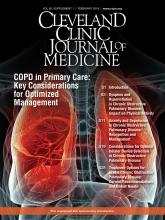More than 13 million people in the United States have been diagnosed with chronic obstructive pulmonary disease (COPD),1 a complex, heterogeneous respiratory condition characterized by persistent, and usually progressive, airflow limitation.2,3 The prevalence of COPD is rising: It has been declared the third leading cause of death in the United States,4 and the World Health Organization has predicted that it will become the third leading cause of death worldwide by 2030.5 This increase is driven by an aging population, and tobacco smoking, which is the primary risk factor for COPD in high-income countries.6
Symptoms of COPD, as well as the severity of these symptoms, can vary, but patients typically present with dyspnea, chronic cough, and sputum production.2 These symptoms are often underreported by patients with COPD,2 but have a significant impact on patients’ day-to-day lives, adversely affecting their quality of life and their ability to engage in physical activity, further contributing to disease progression.7,8
Comorbidities are common in patients with COPD, and can pose significant challenges to the diagnosis and management of the condition. Some of these comorbidities, such as lung cancer and ischemic heart disease, share a common etiologic pathway with COPD—smoking; while others, such as anxiety and depression, appear to be unrelated to COPD pathogenesis, although they may share a systemic inflammatory basis, and are highly prevalent in patients with COPD.9
Primary care physicians are the key point of contact for most patients with COPD,10 and play a critical role in diagnosis, drug and device selection, and long-term disease management of COPD and associated comorbidities. A number of pharmacologic and nonpharmacologic treatment options are available to manage COPD symptoms, which can confer considerable benefits to patients. Selection of pharmacologic treatment should be based on an individual patient’s symptom burden and their exacerbation history, and it is important that physicians are aware of when therapy should be escalated, and indeed stopped if no longer required.2
Proper device selection is an important part of choosing treatments for patients with COPD. A variety of inhaler devices are available for COPD medications, and it is important that devices are matched to patients’ needs and preferences based on device characteristics and individual patient capabilities.
The aim of this supplement is to provide readers with an introduction to 4 key topics critical to the effective management of COPD in primary care, highlighting best practices to optimize patient care and outcomes. In the first article, Dr. Marchetti and Dr. Kaplan review physical activity in COPD, discussing its inter-relationship with dyspnea and hyperinflation, and its importance in modifying disease progression.
The second article examines anxiety and depression in COPD. Prof. Yohannes, Dr. Kaplan, and Dr. Hanania review the prevalence, mechanisms, and impact of the 2 often overlooked and undertreated psychologic comorbidities in patients with COPD. The authors provide guidance on how anxiety and depression can be detected and managed in patients with COPD in a primary care setting.
The third article is authored by Dr. Dhand, Dr. Cavanaugh, and Dr. Skolnik, and reviews the device options available for COPD pharmacologic therapy. It summarizes the key features of each respective inhaler device, discusses considerations for patient-device matching, and emphasizes the importance of training in correct device use.
Finally, Dr. Victor Kim and I assess different COPD treatment options in the supplement’s fourth article. We review the latest updates in recommendations from both the Global Initiative for Chronic Obstructive Lung Disease (GOLD) and the COPD Foundation, discuss the importance of personalized treatment goals for patients, and review how to address current unmet needs in patient management.
Footnotes
DISCLOSURES
Dr. Yawn reports receipt of personal payments for COPD-related advisory boards for AstraZeneca, Boehringer Ingelheim GmbH, and GlaxoSmithKline, and COPD-related research grant funding from Boehringer Ingelheim GmbH. She has served as a content developer and peer reviewer for Medscape and UpToDate, and has received grant support from the National Heart, Lung, and Blood Institute and the Patient-Centered Outcomes Research Institute for COPD-related research.
Funding for this article was provided by AstraZeneca LP (Wilmington, DE, USA). Medical writing support was provided by Hannah Burke, BSc, of Core (London, UK) and editorial support was provided by Maryam Vahdat, PGDip, of Core (London, UK), which were funded by AstraZeneca LP (Wilmington, DE, USA), in accordance with Good Publication Practice guidelines (Battisti WP et al. Ann Intern Med. 2015;163:461–464. doi: 10.7326/M15-0288).
This article is being co-published in The Journal of Family Practice and Cleveland Clinic Journal of Medicine.
- © 2019 The Cleveland Clinic Foundation. All Rights Reserved.






